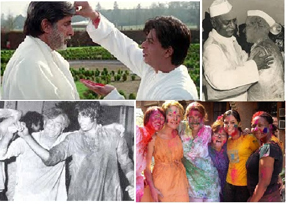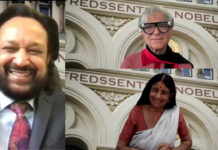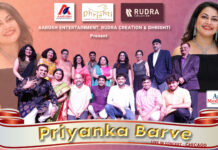
Holi is an important and a very colorful festival of India. It is celebrated at the end of the winter season on the last full moon day of the lunar month Phalgun (February/March), or Phalgun Purnima, with joy and gaiety. This year Holi falls on March 17.
People play by showering colored powder and colored water through water sprays and balloons. At the end, friends and families often come together for sharing meals and sweets. In its modern street avatar some amount of hooliganism mars this wonderful festival of love, devotion, togetherness and joy, of vibrant colors of life.
Hindus believe it is a time of enjoying Spring’s abundant colors and saying farewell to winter. Holi festivities act as a justification to reset and renew ruptured relationships, end conflicts and accumulated emotional impurities from past. It is a veritable new beginning.
Holi has existed for over 2000 years. The meaning of the festival is believed to have changed over the years. Earlier it was a special rite performed by married women for the happiness and well-being of their families, and the full moon was worshiped. Thus the full moon festival of Holika gradually became a festival of merrymaking, and commencement of the spring season – Vasanta-Mahotsava (Spring festival).
The literal meaning of the word ‘Holi’ is ‘burning’ and originally the festival was known as ‘Holika’. Among various legends, the most prominent of all is the legend associated with demon king Hiranyakashyap.
Hiranyakashyap wanted everybody in his kingdom to worship only him, but to his great disappointment, his son, Prahlad became an ardent devotee of Lord Naarayana. Hiranyakashyap commanded his sister, Holika to enter a blazing fire with Prahlad in her lap. Holika had a boon whereby she could enter fire without any damage to herself.
However, she was not aware that the boon worked only when she enters the fire alone. Prahlad was saved by the grace of God for his extreme devotion. The festival, therefore, celebrates the victory of good over evil and also the triumph of devotion.
In Braj region of India near Mathura, where Krishna grew up, the festival is celebrated for 16 days (until Rangpanchmi), in commemoration of the divine love of Radha for Krishna, a prominent Hindu deity. Holi thus is celebrated as festival of love – Kama Mahotsava.
Legend of Lord Krishna is also associated with play with colors. The Lord started the tradition by applying color on his beloved Radha and other Gopis. Gradually, the color play gained popularity with the people and became a tradition.
There are a lot of paintings and murals in the temples of medieval India which provide a pictorial description of Holi. A Mewar painting (circa 1755) shows the Maharana with his courtiers. While the ruler is bestowing gifts on some people, a merry dance is on, and in the center is a tank filled with colored water. A Bundi miniature shows the king seated on a tusker, and from a balcony above, some damsels are showering gulal (colored powders) on him.
In some parts of India, especially in Bengal and Orissa, Holi Purnima is also celebrated as the birthday of Shri Chaitanya Mahaprabhu, the supreme embodiment of love and devotion of the divine pair of Radha-Krishna.
The writer is Air India Manager-Midwest, Chicago Illinois
Rishikant Singh






